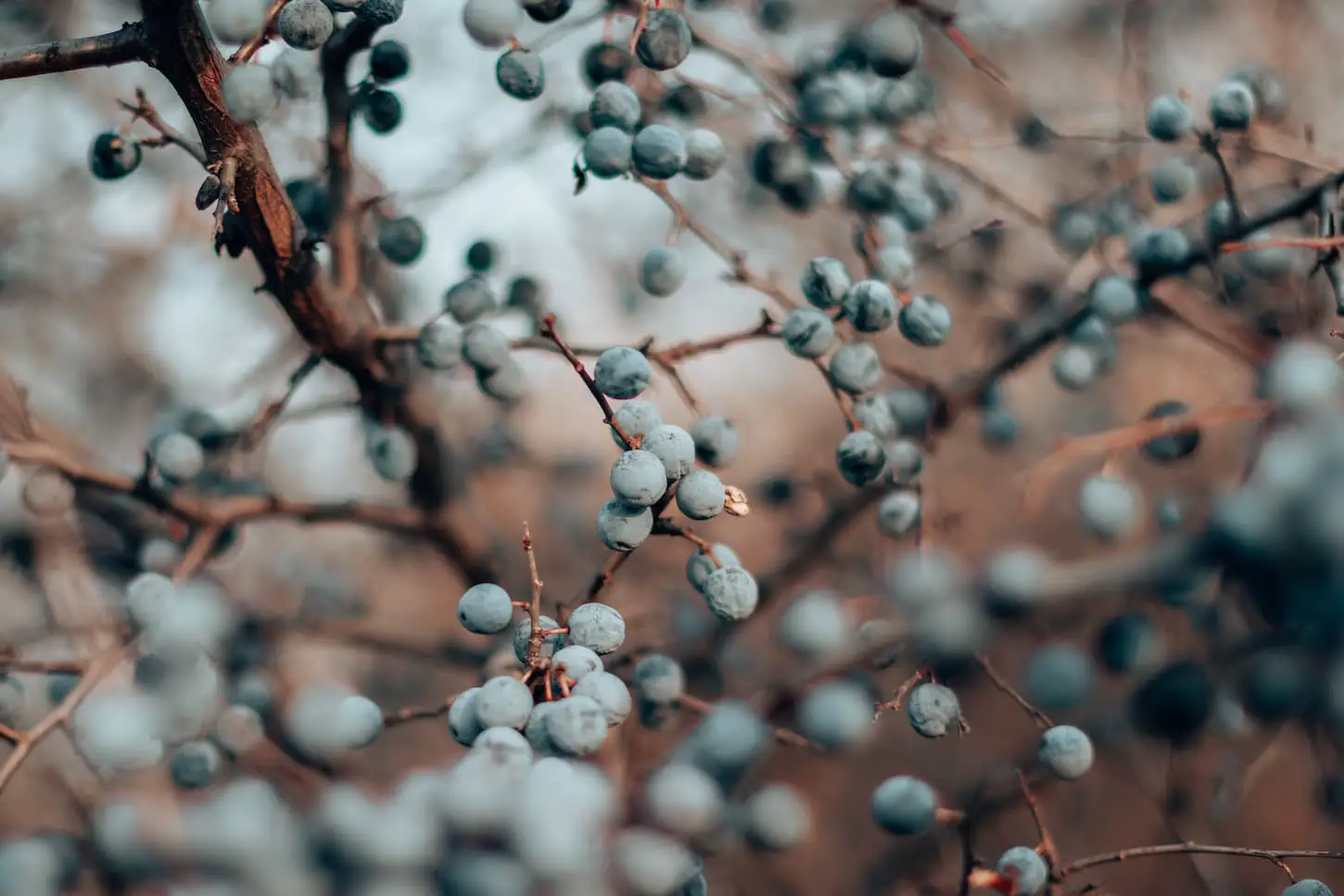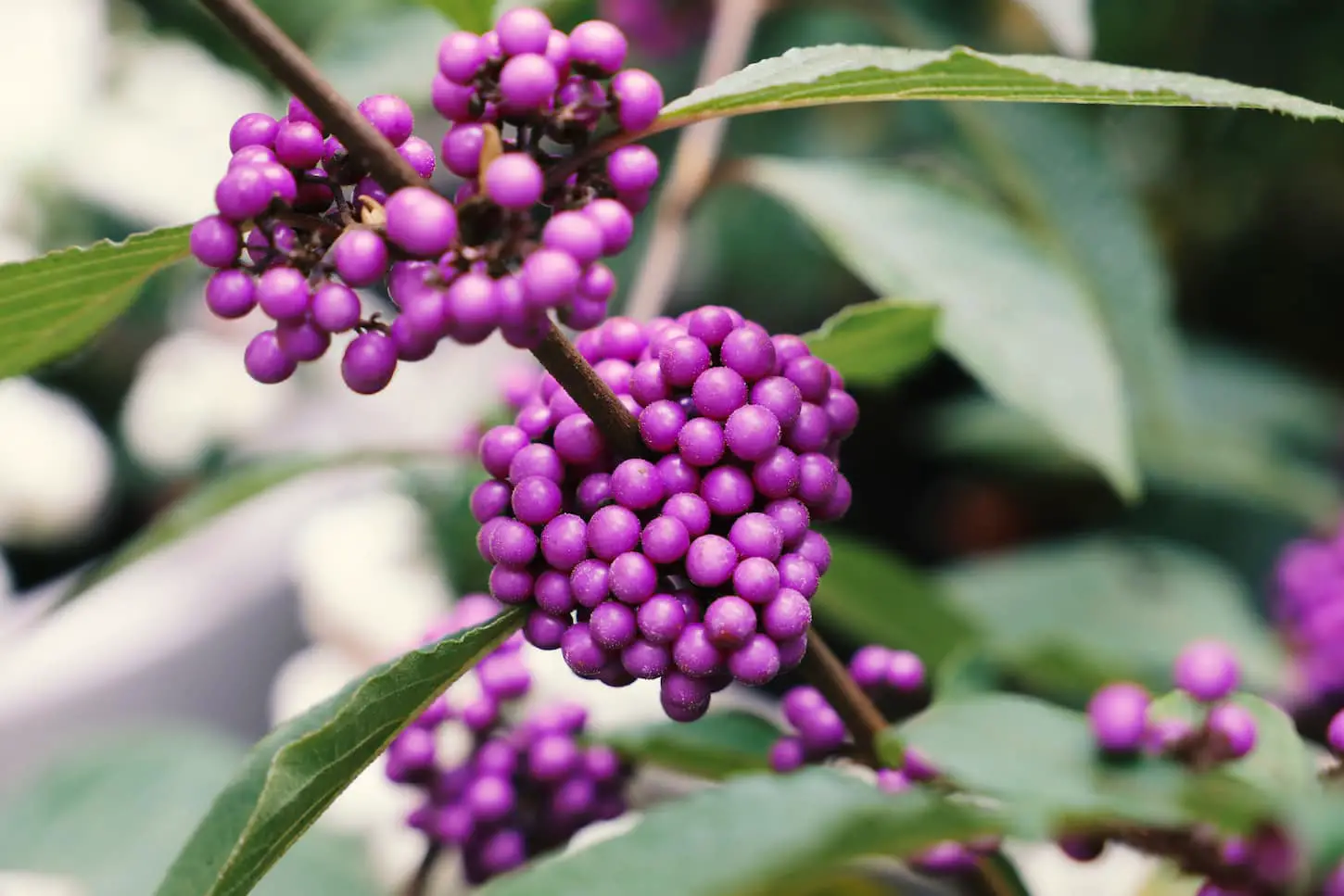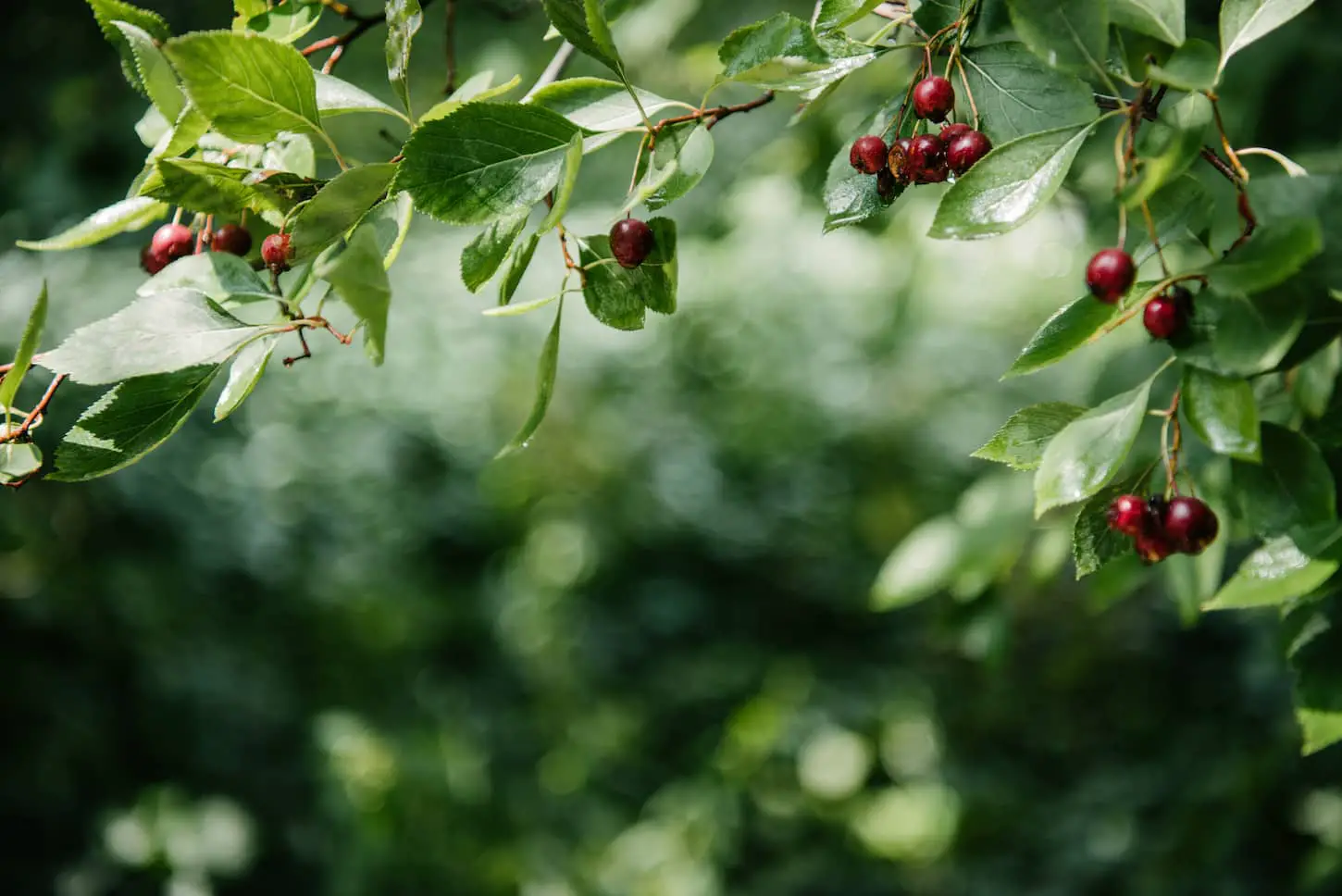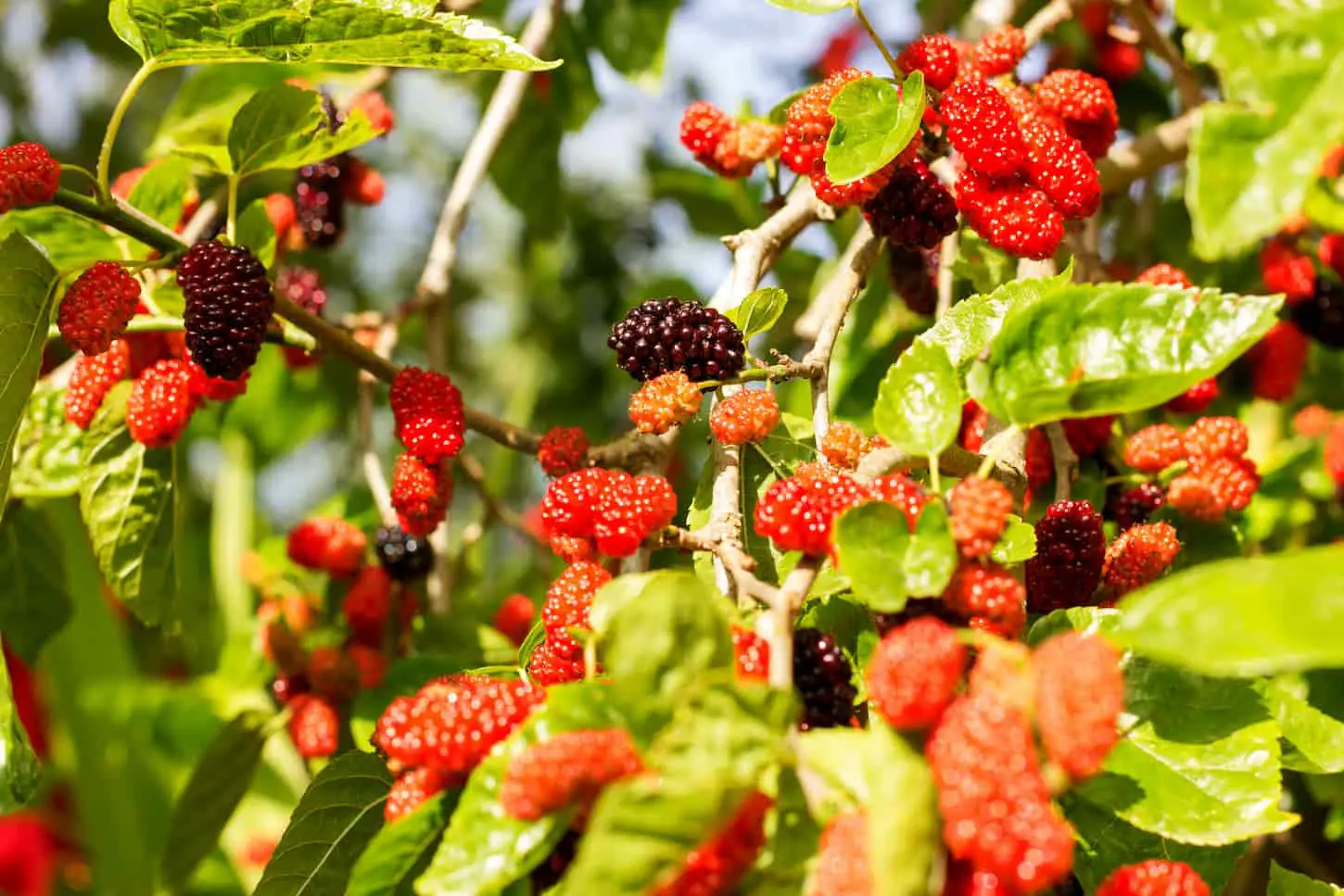Berries are known to grow mostly in bushes, but there are also tree berries, which are often more obscure and less known. These berries are rarer, and many gardeners wonder what varieties of berries grow on trees and what they look like.
The most common tree berries are:
- Blackthorn berries
- Spindle berries
- Mulberries
- Soapberries
- Yew berries
- Deciduous holly berries
However, not all these berries are edible; some should only be grown as decoration. In this article, we’ll look at berries to see which ones we should grow!

Berries: Types That Grow on Trees
The most common kinds of berries that grow on trees are deciduous holly berries, blackthorn berries, spindle berries, mulberries, soapberries, and yew berries.
The definition of berries is very broad and unspecific – a berry is a small, juicy, round fruit with pulp. While the most common berries are strawberries, blueberries, currants, and raspberries, grapes, and tomatoes are also berries (strictly technically speaking).
Most of these berries grow in shrubs, though. The most common types of berries that grow in trees are the berries of deciduous holly, blackthorn berries, spindle berries, mulberries, soapberries, and yew berries.
Are berries that grow on trees edible?
There are edible berries that grow on trees, but there are also poisonous berries that grow on them. It has nothing to do with the type of plant and everything to do with the variety of berries, so it is important to identify the exact berry species before eating it.
Whether the berries are grown in shrubs or trees has nothing to do with their toxicity. Both tree and shrub berries have toxic varieties. Both tree and shrub berries have edible varieties.
Many of these berries are edible only under certain circumstances – they can be toxic when they’re unripe but edible when ripe, for example.
Are any tree berries dangerous or poisonous? (don’t eat these)
There are poisonous tree berries, such as yew, spindle, deciduous holly, and more. Even normally safe berries are dangerous to eat if eaten unripe because of the milk sap and other elements in the unripe fruit.
Mulberries, for example, aren’t toxic if they’re ripe. However, unripe fruit contains a toxic milky sap just like the rest of the plant – this can cause terrible nausea and even hallucinations.
Even when mulberries are ripe, eating too many will have a laxative effect, so this isn’t recommended. To summarize, mulberries are edible only if they’re ripe, but we shouldn’t eat too many of them even then!
Spindle berries are poisonous to humans; but are common food for mice, birds, and foxes. The spindle is grown as a decoration – not for food, at least for humans. Then again, I’ve never seen a mouse grow a spindle for decor purposes. That would be kind of cool to see.
The berries of deciduous holly are also poisonous, especially for pets and small children. They can cause an extreme reaction in the stomach, as well as drowsiness. According to the National Capital Poison Center, children can develop symptoms after eating as few as two berries.
The berries of yew trees are poisonous, but research says that the effects aren’t extreme, and they’re usually confined to gastrointestinal symptoms, such as vomiting, diarrhea, and dehydration.
Soapberry is also toxic as it contains saponin and is traditionally used as a fish poison. However, this doesn’t have a devastating effect on the human body, as we don’t absorb saponin (the toxic ingredient) well.
Research says eating small quantities of soapberries won’t harm us (and we might not even feel any pain), but they won’t taste good. Even so, we shouldn’t eat them in great quantities (or eat them at all if we have a choice). If you want to eat soapberries, we can remove the saponins from them by cooking them!
Right now, it might seem that every single berry species is poisonous or only edible in very small quantities. This isn’t true, as blackthorn berries aren’t toxic.
Blackthorn leaves, flowers, and seeds are toxic, but the fruits are edible (source).
This is why blackthorn is often used to make jam, fruit pies, teas, and juices. The berries themselves can also be eaten without any preparation.

What Are the Purple Berries That Grow on Trees?
Blackthorn berries are the most common purple berries that grow on trees. Other common varieties include mulberries, hackberries, and serviceberries. Blackthorns, serviceberries, and hackberries are edible, while mulberries have a laxative effect if we eat too many.
Color is one of the main identifying factors when it comes to berries. Most berries only have two colors – one when they’re unripe (usually white or green) – and the other when they’re ripe (red, pink, purple, blue, black).
Aside from that, berries can also be identified by the type of plant they grow on. Blackberries, for example, don’t grow on trees. They grow exclusively on shrubs; no matter how large the shrub may be, it’s still not a tree. So, if we come across a tree with berries that look like blackberries, we can instantly recognize them and know not to eat them.
- Blackthorn berries, which we already mentioned, are a very common species of purple berries that grow on trees. They’re about the size of a marble and characteristically purple.
- Mulberries are usually black, purple, or dark red. Since these colors are similar, a berry can be any of the three.
- Hackberries are also purple – about 0.3 inches in diameter and become ripe in the fall (they’re green during the summer). Hackberries aren’t toxic and are entirely edible.
- Serviceberries are very similar to blueberries, but they grow on trees. They become purple when they ripen, usually in late spring, but until then, they’re pink or red. Serviceberries are completely edible.
Black berry varieties that grow on trees
Black berry varieties that grow on trees include mulberries, acai berries, elderberries, and farkleberries.
- Mulberries (they seem omnipresent at this point) can also be black, among other colors.
- Acai berries come from acai palm trees. These berries are small, round, and entirely black – they’re about an inch in diameter and look like small berries. Acai berries are edible, healthy, and quite common in the Amazon River delta. They’re much less common elsewhere unless you’ve got a greenhouse.
- Elderberries are found in elder trees, where they group in large clusters. The berries are small, black, and toxic if uncooked. Cooked berries, however, can be eaten. In most cases, however, they cause nothing more than indigestion.
- Farkleberries grow in the American Southeast, with trees reaching almost 13 feet in height. The berries are black, round (about 0.25 inches in diameter), and edible (but bitter and distasteful).
Red berries that grow on trees
Goji and dogwood berries grow on trees.
- Goji berries are also known as wolfberries, these berries are native to Asia, but they are cultivated all over the world. The berries are red, and they look like large raindrops. Aside from eating them fresh, they are often eaten dried.
- Dogwood berries grow on dogwood trees and are common in southeastern Europe. The berries are bright red, completely edible, and often used for syrups.
What berries fall off of trees?
All berries fall off the plant eventually if not picked or eaten. Plants like strawberries, with fruit that grows just above the ground, take a lot of time to fall. But berries that grow on trees will wither if not eaten or picked and fall to the ground.
This is a problem in residential neighborhoods because berries that fall on the concrete will stain it. Serviceberries and blackthorn berries are especially bad in this regard, as their colors are intense.
If we plan on planting a blackthorn tree or a serviceberry tree next to the pavement, we ought to pick the berries before they fall and make a huge mess. Or, if we miss some berries, we ought to at least clean up the mess.

Can These Berries Grow in Trees?
While most berries grow in shrubs, some berries grow in trees. Look at some of the most common types of berries and see if they are grown in trees or a shrub-only fruit. The berry varieties are listed alphabetically for convenience.
Blackberry: a shrub
Blackberries don’t grow in trees – they’re only grown in shrubs. The shrubs themselves can reach massive sizes if they’re not controlled, and they are very thorny, making them a bit of a nuisance.
The fruit is distinctly black with a sweet taste, although it can be a bit sour if they’re not completely ripe. Today, they’re grown worldwide, with Mexico being the greatest producer of blackberries.
Does blackberry pie sound like a delicious treat? Here is the recipe: Homestead Blackberry Pie Recipe.
Blueberry: a shrub
Blueberries don’t grow on trees – they’re grown in shrubs that can reach 13 feet in height, which is why some people confuse them for trees. They’re easily recognized due to their blue, pea-sized berries. They’re closely related to cranberries and huckleberries.
They’re grown worldwide, with Canada being the greatest producer and the United States, Poland, Netherlands, Turkey, South Korea, and Japan following closely.
Cranberry: a shrub
Just like blackberries, cranberries are also grown in shrubs. The shrubs are usually low, but their vines can grow up to 7 feet long and 20 inches tall.
Bees are the most common pollinators of cranberry plants, while the USA, Canada, and Chile are the world’s greatest fruit exporters. In the wild, cranberries grow in wetlands and are especially common in bogs and marshes as they prefer acidic soil.
The berries themselves are a bit sour and bitter, but enjoyably, and most of them are turned into juice and sauce. Aside from eating them fresh or drinking the juice, cranberries are also dried.
Mulberry: a tree
Mulberries are a common example of berries that grow in trees. There are over 60 species, usually growing in temperate regions, and some of them can grow to extreme heights of up to 80 feet!
The berry itself is usually no longer than 1.25 inches. It can be purple, red, or black when ripe but green when unripe.
Strawberry: a shrub
Strawberries can’t be grown in trees, and the plant itself can’t be characterized as a bush or a shrub. The strawberry is actually a herbaceous plant, meaning that they don’t have woody stems above the ground.
People often group strawberries with raspberries and blackberries because of the similar berry, but the plant itself is a completely different type.
The berry itself is characteristically red, and they vary in size from one cultivar to the other. They’re very sweet, making them possibly the most popular type of berry in the world, with China being the biggest exporter.
Possibly the best thing about strawberries is that they’re easy to grow, making them popular in home gardens.
Raspberry: a cane or shrub
Raspberries aren’t shrubs – technically speaking – but the plant’s shape resembles a shrub very much, which is why most people call them shrubs. They’re aggregate fruit – just like strawberries.
The fruit of the raspberry is red, sweet, and smaller than the strawberry. Before ripening, the fruit is white or green. Aside from the classic red raspberry, there are also black, pink, purple, and golden raspberries.
Most raspberries are produced in Europe, especially in Russia, Poland, and Serbia, with Mexico and the United States also being notable producers.
Do you like homemade raspberry jam? Get my always-perfect raspberry jam recipe here.
Red Currant: a shrub
Red currants grow in shrubs, usually no taller than 5 feet, and they might just be the wildest of all the berries on this list, as they’re often found in the wild. They’re never found in trees, though, as they only exist in shrubs.
They’re characteristically red, as the name suggests, and tart to the taste. Aside from eating them raw, they’re often served as a side dish or turned into jam.

What Tree Has Red Berries Like Raspberries?
Mulberries are similar to raspberries in shape, can be red or pink, and grow on trees. Other possibilities include loganberries, thimbleberries, or tayberries. Aside from them, though, there are not many tree berries that resemble raspberries.
This doesn’t mean there aren’t plenty of berries similar to raspberries that grow in shrubs.
Possibly the most popular species is the loganberry. This plant was created by crossing the European raspberry and the North American blackberry. It’s entirely edible, and the fruit is slightly longer than the raspberry fruit. However, they’re not very common in the wild and are usually found on farms.
Thimbleberries, on the other hand, are found in the wild. These berries are almost identical to raspberries, but the fruit is noticeably rounder (it looks like someone squished a berry or tried to turn it into a perfect ball). These berries are often turned into jam or eaten as a snack.
The tayberry is another species of berry often found in the wild. The fruit is very similar to raspberries, but it tastes larger and sweeter. Aside from being eaten fresh, it’s often used in pies, jam, and wine.
My sister’s neighbor has a red, raspberry-like tree. It’s growing over the fence into my sister’s yard. The fruit is delicious (a tad tart), and we’re not 100% sure what it is, so she calls it her “adopted raspberry tree.” I think it’s mulberry, though.
Key Takeaways and Next Steps
The most popular berries only grow in shrubs or deciduous plants, as most tree berries are poisonous to people. There are exceptions, like blackthorn berries, but tree berries should be grown for decoration, not food.
If you are growing berries at home and would like some extra tips, these articles are full of information to help your berry gardening and harvest reach the next level.
- Complete Guide to Berries: Plant, Grow, Harvest, and Care
- Pruning Berries: The Ultimate Guide
- How Much Sun And Shade Can Berries Tolerate? A Complete Guide
Resources
Learning from your own experience is essential, but learning from others is also intelligent. These are the sources used in this article and our research to be more informed as homesteaders.
- Editorial. (2021, May 26). Blackthorn. . . Botanical Online. https://www.botanical-online.com/en/medicinal-plants/blackthorn-toxicity
- Holly Berries. (n.d.). Poison Control. https://www.poison.org/articles/holly-berries
- NCBI (n.d.). https://pubmed.ncbi.nlm.nih.gov/9656977/
- Ohio Perennial and Biennial Weed Guide. (n.d.). https://web.archive.org/web/20120412062338/http://www.oardc.ohio-state.edu/weedguide/singlerecord.asp?id=200
- Perry, M. (2022, May 25). Mexico’s Berry Bounty Fuels Trade Dispute – U.S. Consumers Dismiss U.S. Berry Farmers’ Complaints as ‘sour Berries.’ American Enterprise Institute – AEI. http://www.aei.org/publication/mexicos-berry-bounty-fuels-trade-dispute-u-s-consumers-dismiss-u-s-berry-farmers-complaints-as-sour-berries/
- Sapindus saponaria Soapberry, Wild Chinaberry, Florida Soap Berry, Soap Nut, Soap Tree PFAF Plant Database. (n.d.). https://pfaf.org/user/Plant.aspx?LatinName=Sapindus+saponaria
- Spindle | The Wildlife Trusts. (n.d.). https://www.wildlifetrusts.org/wildlife-explorer/trees-and-shrubs/spindle
- Tree Species Highlight | Edmond, OK – Official Website. (n.d.). https://www.edmondok.gov/1015/Tree-Species-Highlight
